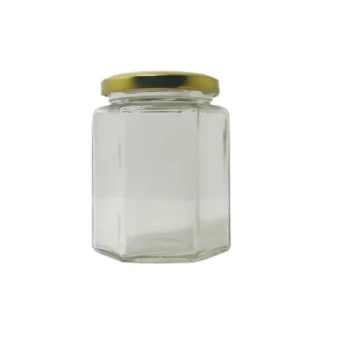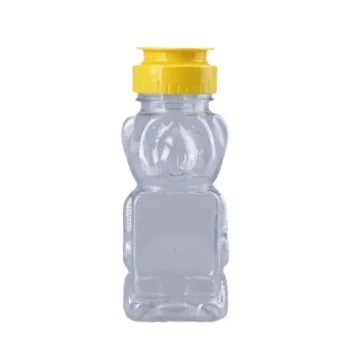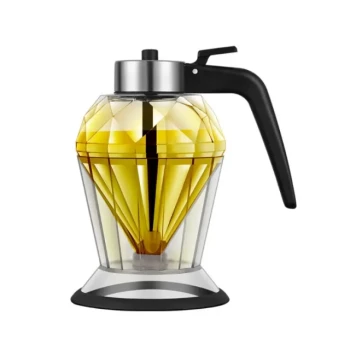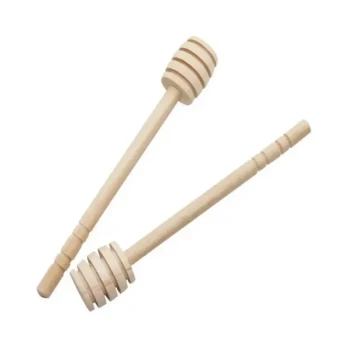To effectively remove sticky honey residue, you must dissolve its sugars rather than just wiping them. The most reliable method is to apply hot water mixed with a few drops of dish soap directly to the spill. For tougher, crystallized honey, adding a small amount of white vinegar can help break it down even faster.
Honey's stickiness is due to its high concentration of sugar in a low-water solution. The key to cleaning it is not forceful scrubbing, but using heat and a surfactant (soap) to dissolve these sugars, transforming the sticky mass into an easily wipeable liquid.
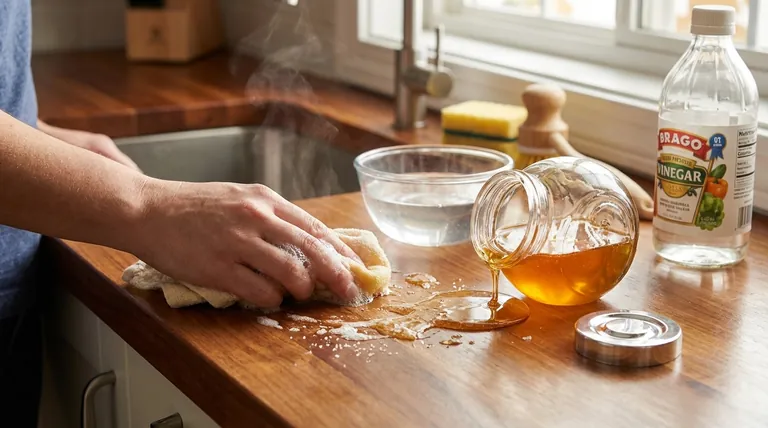
Why Honey is So Difficult to Clean
To defeat the enemy, you must first understand it. Honey's resilience as a sticky mess comes down to its basic chemical composition.
The Science of Stickiness: Sugar and Water
Honey is a supersaturated sugar solution, primarily composed of fructose and glucose with very little water content. This low water content makes it thick, or viscous.
The sugar molecules are "hygroscopic," meaning they readily seek to form strong hydrogen bonds with other surfaces, which is what we perceive as stickiness.
The Problem with Scrubbing
Simply trying to scrub or wipe away honey, especially with a dry or cold cloth, often fails. You are fighting against those strong chemical bonds without first breaking them down.
This action usually just smears the honey, spreading the sticky sugar molecules over a wider surface area and making the problem worse.
The Step-by-Step Method for Flawless Removal
This process works by systematically breaking down the honey's structure, making it simple to remove without leaving behind a tacky film.
Step 1: Dissolve with Hot Water
Heat is the most critical agent. Hot water provides the thermal energy needed to excite the sugar molecules, dramatically increasing their solubility. This effectively melts and liquefies the thick, sticky honey.
Step 2: Break Down Residue with Soap
Dish soap acts as a surfactant. Its molecules have a unique structure that helps lift the sugar and other trace components away from the surface and suspend them in the water. This prevents a sticky film from reforming as you wipe.
Step 3: Let the Solution Sit
Allowing the hot, soapy water to sit on the spill for a few minutes is crucial. This "dwell time" gives the heat and soap time to fully penetrate and dissolve the entire spill, especially if it's large or has started to dry.
Step 4: Wipe, Don't Smear
Use a clean cloth or sponge to absorb the now-liquefied honey solution. Wipe inward from the outside of the spill toward the center to contain the mess. Rinse the cloth and repeat with fresh, hot water to remove any final traces.
Common Pitfalls to Avoid
Even with the right method, a few common mistakes can lead to frustration. Understanding them ensures a perfect cleanup every time.
Using Only Water
Using only water, especially cool water, can thin the honey into a broader, less visible, but still sticky film. Without soap to lift the sugar molecules completely, you are often just diluting the problem.
Applying to the Wrong Surface Immediately
This method is ideal for non-porous surfaces like countertops, sealed wood, glass, or laminate. On porous materials like fabric or unsealed wood, the honey can soak deep into the material.
For fabrics or carpets, you should first gently scrape off any excess honey. Then, blot the area repeatedly with a cloth soaked in the hot, soapy water solution rather than pouring the liquid on.
Ignoring Crystallized Honey
If honey has dried and crystallized, it may be more stubborn. In this case, adding a splash of white vinegar to your hot, soapy water is highly effective. The mild acid in the vinegar helps break down the hardened sugar crystals more rapidly.
Making the Right Choice for Your Spill
Tailor your approach based on the specific mess you are facing for the most efficient cleanup.
- If you have a fresh, small spill on a hard surface: A simple wipe with a cloth soaked in hot, soapy water is all you need.
- If you have a large or partially dried honey spill: Apply the hot, soapy water and let it sit for at least five minutes before wiping.
- If you are dealing with stubborn, crystallized honey: Add a splash of white vinegar to your hot, soapy water solution to accelerate the breakdown of the sugar crystals.
By focusing on dissolving the sugar first, you can clean any honey mess without the sticky struggle.
Summary Table:
| Situation | Recommended Solution | Key Tip |
|---|---|---|
| Fresh Spill on Hard Surface | Hot water + dish soap | Wipe immediately; no dwell time needed. |
| Large or Dried Spill | Hot water + dish soap | Let solution sit for 5+ minutes to penetrate. |
| Crystallized Honey | Hot water + soap + white vinegar | Vinegar breaks down hardened sugar crystals. |
| Porous Surfaces (e.g., fabric) | Blot, don’t pour | Scrape excess first, then blot with solution. |
Tired of sticky beekeeping equipment? HONESTBEE supplies commercial apiaries and distributors with durable, easy-to-clean beekeeping supplies. Our equipment is designed to withstand honey’s stickiness, making your cleanup process faster and more efficient. Contact us today to explore our wholesale-focused product catalog and streamline your beekeeping operations.
Visual Guide
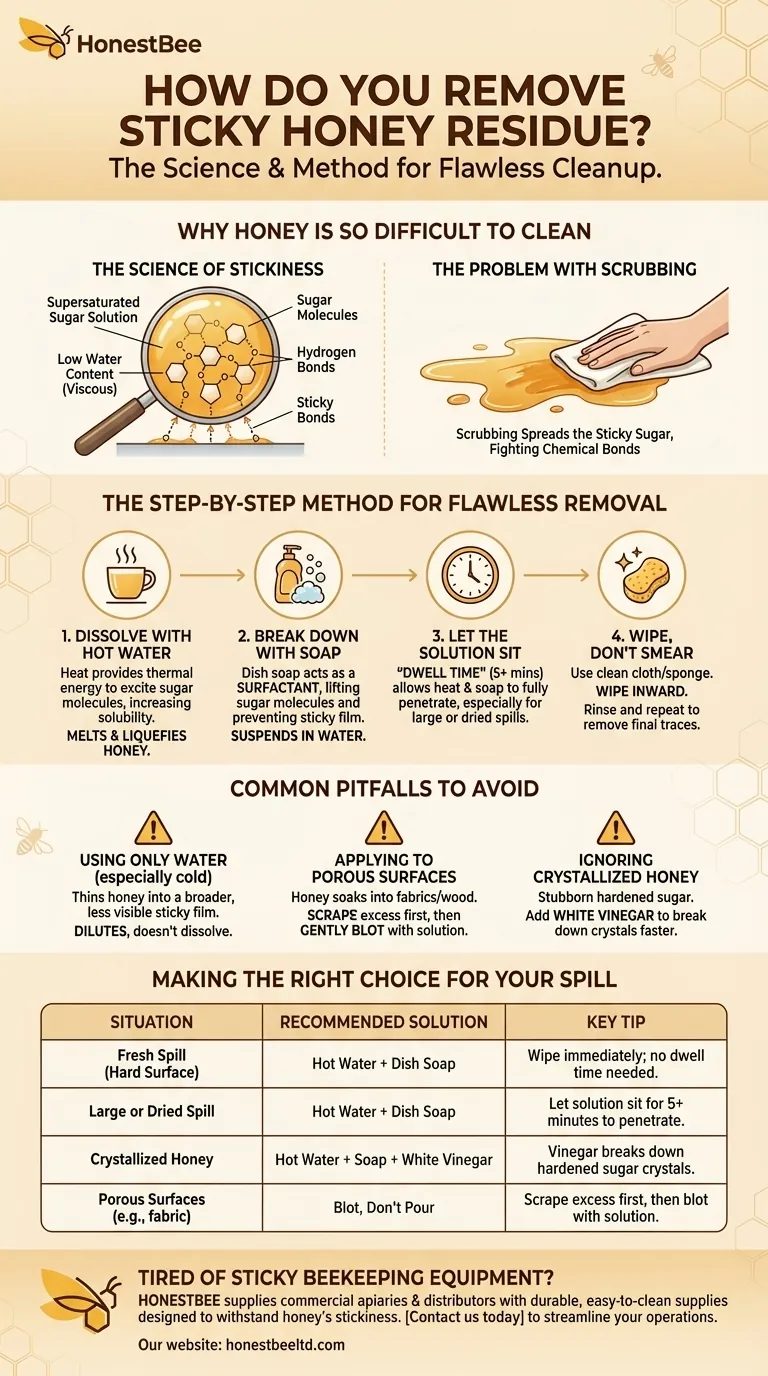
Related Products
- Classic Drum Shaped Glass Honey Jar with Airtight Lid
- Hexagonal Glass Honey Jars with Metal Lug Caps Elegant Versatile Packaging
- Inverted Squeezable Honey Jar with No Drip Flip Top Cap for Easy Pouring
- Classic Honey Bear Jars with Flip Top Dispensing Cap for Liquid Sweeteners
- Pneumatic Double Nozzle Honey Filling Bottling Packaging Machine
People Also Ask
- What precautions should be taken when packing honey? Ensure Quality from Hive to Jar
- How long to let honey settle before bottling? Achieve Crystal-Clear Honey for a Premium Product
- Which container is best for storing honey? Preserve Purity & Flavor with the Right Choice
- How long can honey last in a bottle? Discover the Secrets to Its Indefinite Shelf Life
- How does the role of honey bees influence the choice between raw and processed honey? Preserve the Bee's Work.

